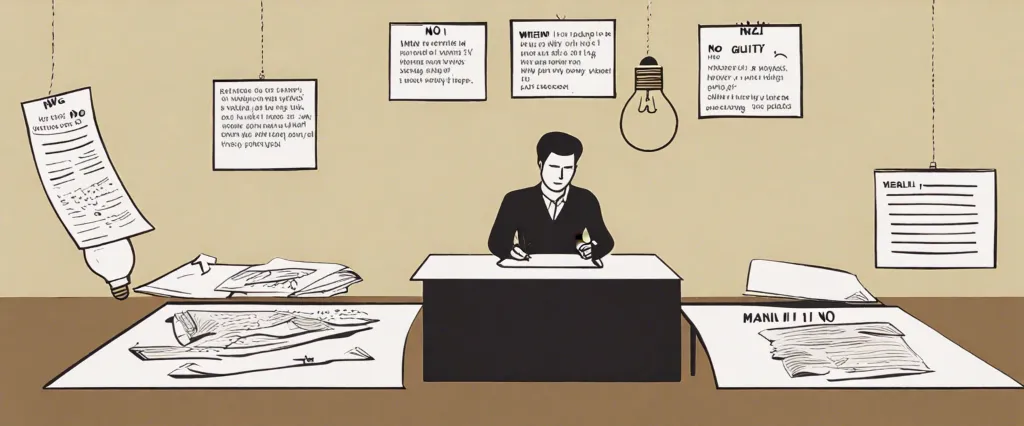
In “When I Say No, I Feel Guilty,” Manuel J. Smith presents readers with an empowering guide on assertiveness and effective communication. Published in 1975, this self-help book explores the difficulties many individuals face when expressing themselves honestly and confidently. Through practical techniques and insightful anecdotes, Smith tackles the issue of guilt that often accompanies saying no. As a renowned psychologist and pioneer in the field of assertiveness training, Manuel J. Smith revolutionized the way society perceives assertiveness, making this book a valuable resource for anyone seeking to communicate with both authenticity and empathy.
Chapter 1: The Power of Assertiveness
Chapter 1: The Power of Assertiveness delves into the concept of assertiveness and its significance in our personal and professional lives as discussed in the book When I Say No, I Feel Guilty by Manuel J. Smith.
The chapter begins by highlighting the importance of assertiveness as a way to express oneself honestly, directly, and confidently, while respecting the rights and feelings of others. It introduces the idea that people often struggle with assertiveness due to the fear of rejection, conflict, or being seen as selfish. The author emphasizes that assertiveness is a learnable skill and can be developed through practice.
Smith proceeds to outline three primary behavior patterns: the submissive behavior pattern, the aggressive behavior pattern, and the assertive behavior pattern. Submissive individuals tend to prioritize others’ needs and feelings over their own, often leading to feelings of resentment. Aggressive individuals prioritize their own needs and feelings at the expense of others, which can create resentment and conflict. In contrast, assertive individuals value their own needs and feelings without devaluing those of others, promoting mutual respect and open communication.
The chapter also explores various scenarios that demonstrate assertiveness in action, showcasing how assertive behavior can effectively address conflicts and improve relationships. Smith emphasizes that assertiveness involves expressing one’s opinions, feelings, and boundaries clearly and directly, using “I” statements, and accepting responsibility for one’s own emotions.
In summary, Chapter 1 of When I Say No, I Feel Guilty brings attention to the power of assertiveness and its role in fostering healthy relationships and personal well-being. It emphasizes that assertiveness is a skill that can be learned and applied in various situations to communicate effectively while maintaining self-respect and respect for others.
Chapter 2: Understanding Manipulative Behavior
Chapter 2 of Manuel J. Smith’s book “When I Say No I Feel Guilty” explores the concept of manipulative behavior and provides a framework for understanding it. The chapter highlights that being manipulated is often an involuntary response to manipulative tactics employed by others, and it focuses on empowering individuals to recognize and overcome manipulation.
The chapter starts by explaining that manipulative behavior is a common phenomenon used by people to control others and get what they want. It emphasizes that manipulation is not inherent to certain individuals or personality traits but is a learned behavior that anyone can adopt. The author stresses that it is crucial to understand and distinguish manipulative tactics in order to effectively respond to them.
Smith then introduces three primary methods of manipulation: “the Guilt Trip,” “the Put-Down,” and “the Martyr.” He describes each method in detail, explaining how guilt, insults, and self-sacrifice are employed to influence and control others. By providing concrete examples and scenarios, the author helps readers recognize these tactics in their own lives, enabling them to develop a better understanding of manipulation.
Furthermore, the chapter offers insights into the psychology behind manipulation, emphasizing that manipulators often have low self-esteem and a fear of rejection. They utilize manipulation to compensate for their insecurities and gain a sense of power and control.
In summary, Chapter 2 of “When I Say No I Feel Guilty” educates readers about manipulative behavior, its various tactics, and the psychological motivations behind it. By increasing awareness and understanding of manipulation, readers are better equipped to identify and respond to manipulative behavior, ultimately empowering themselves to maintain their boundaries and live a more assertive and fulfilling life.
Chapter 3: The Origins of Guilt
In Chapter 3 of “When I Say No I Feel Guilty” by Manuel J. Smith, the author delves into the origins of guilt and how it affects our daily lives. He begins by stating that guilt is not an inherent feeling but is rather a learned response, which means that we acquire it through our upbringing and interactions with others.
Smith highlights that guilt is often used as a manipulation tool in our society. From an early age, children are conditioned to feel guilty if they don’t comply with the demands or expectations of their parents and caregivers. They are made to believe that saying no or expressing their own needs is selfish or wrong. Consequently, as adults, many individuals still carry this guilt, constantly doubting their own choices and feeling responsible for others’ emotions.
The author explains that guilt arises from our fear of rejection and our desire for approval. We associate guilt with being a “good person” who puts others’ needs before their own. This connection between guilt and acceptance creates a constant cycle where saying no becomes extremely difficult, as it may trigger feelings of guilt and abandonment fears.
Smith suggests that breaking free from this guilt cycle requires understanding its origin and challenging the irrational beliefs associated with it. By recognizing that guilt is a learned response and not an inherent truth, individuals can start to redefine their boundaries, set realistic expectations, and prioritize their own needs without feeling guilty. In this process, communication skills, such as assertiveness, become essential tools to express one’s needs and boundaries effectively while maintaining respectful relationships.
Overall, Chapter 3 sets the foundation for understanding guilt’s origin and its consequences on our behavior. It encourages readers to question and challenge the irrational beliefs associated with guilt, empowering them to develop healthier relationships based on honesty, assertiveness, and self-care.
Chapter 4: Assertive Rights and Responsibilities

Chapter 4 of “When I Say No I Feel Guilty” by Manuel J. Smith focuses on assertive rights and responsibilities. It emphasizes the importance of recognizing and exercising one’s rights while also being aware of their corresponding responsibilities. Assertiveness, according to the author, is the middle ground between passive and aggressive behavior.
The chapter begins by listing ten specific rights that individuals have in their interactions with others. These rights include the right to be treated with respect, the right to express feelings and opinions, the right to say no without feeling guilty, and the right to ask for what one wants. Smith asserts that understanding and asserting these rights is crucial for building healthy relationships and avoiding manipulation and control by others.
The author then explores the concept of responsibility, highlighting how it complements rights and lays the foundation for effective communication. Taking responsibility involves being aware of the impact one’s behavior has on others and striving to act in a way that respects their rights as well. Smith explains that being responsible means considering the rights and feelings of others while also being true to oneself.
Furthermore, the chapter offers guidance on how to put assertiveness into practice in various situations. It discusses techniques such as broken record, fogging, and negative assertion, which can be used to respond effectively to manipulation, criticism, or unwanted demands without becoming passive or aggressive.
Overall, Chapter 4 of “When I Say No I Feel Guilty” underscores the importance of understanding and asserting one’s rights while simultaneously being responsible and respectful of others. By combining these skills, individuals can navigate social interactions more effectively, maintain healthy boundaries, and foster open and honest communication.
Chapter 5: Techniques for Saying “No”
Chapter 5 of the book “When I Say No I Feel Guilty” by Manuel J. Smith discusses various techniques and strategies for effectively saying “no” when faced with requests or demands from others. The chapter focuses on empowering individuals to set and maintain healthy boundaries, thereby asserting their autonomy and avoiding feelings of guilt or resentment.
The author begins by emphasizing the importance of knowing and understanding one’s rights. By recognizing that we have the right to say no and the right to choose our own actions, we become better equipped to assert ourselves confidently. Smith introduces the “Broken Record” technique, which involves calmly and assertively repeating our refusal without getting caught up in arguments or explanations.
Additionally, the chapter explores the “Fogging” technique, which involves accepting any validity in the requester’s viewpoint while still maintaining one’s own position. By acknowledging a potential grain of truth in the opposing viewpoint, one can avoid defensiveness or escalating conflict. This technique is particularly useful for dealing with manipulative or persistent individuals.
Furthermore, Smith introduces the technique of using “Negative Assertion” to say no. This approach involves directly and honestly expressing one’s limitations or lack of desire to fulfill the request, without offering excessive apologies or explanations. By being clear, firm, and concise with our responses, we enhance our ability to say no effectively and confidently.
Ultimately, Chapter 5 provides readers with a range of powerful techniques for saying no in a manner that respects both our own boundaries and the rights of others. By utilizing these strategies, individuals can improve their assertiveness skills and minimize feelings of guilt, leading to healthier and more balanced relationships.
Chapter 6: Handling Criticism and Rejection
Chapter 6: Handling Criticism and Rejection of the book “When I Say No, I Feel Guilty” by Manuel J. Smith focuses on how to effectively deal with criticism and rejection. Smith explains that these experiences can be emotionally challenging but can also provide an opportunity for personal growth and empowerment.
The chapter begins by emphasizing the importance of understanding that criticism is a reflection of the criticizer’s opinion and often has little to do with one’s actual worth or abilities. Smith suggests recognizing the ingrained need for approval and the fear of rejection as underlying factors that intensify the negative impact of criticism.
Smith then presents a four-step process for handling criticism effectively. The first step is acknowledgment, where one mentally acknowledges the criticism without letting it affect their emotions or self-image. The second step is to assess the validity of the criticism by analyzing the source and the content with a rational mindset. Next, Smith advises individuals to repudiate any unjust criticism that does not align with their true nature or values. Finally, the chapter discusses self-affirmation, emphasizing the importance of building self-esteem and reminding oneself of their worth despite criticism.
Regarding rejection, Smith highlights that it is an inevitable part of life, and fearing it only limits personal growth and freedom. He advises individuals to see rejection as an opportunity to learn, grow, and explore alternative options. Smith encourages readers to shift their perspective by focusing on the rejection as a rejection of behavior rather than a personal rejection. This change can help individuals let go of resentment and negative emotions associated with rejection.
In summary, Chapter 6 of “When I Say No, I Feel Guilty” provides practical strategies for effectively handling criticism and rejection. By understanding the nature of criticism, assessing its validity, rejecting unjust criticism, and building self-esteem, individuals can navigate these experiences with confidence and personal growth. Rejection, when reframed as an opportunity for learning, fosters resilience and a healthier mindset.
Chapter 7: Dealing with Guilt and Self-Assertion
Chapter 7 of “When I Say No I Feel Guilty” by Manuel J. Smith focuses on the topics of guilt and self-assertion. The chapter explores how individuals can effectively manage their feelings of guilt while improving their ability to assert themselves in various situations.
Smith begins by explaining that guilt often arises from the fear of hurting others or being perceived as selfish. He emphasizes the importance of distinguishing between genuine guilt, which serves as a moral compass, and false guilt, which is driven by irrational beliefs or societal pressures. By recognizing and challenging irrational beliefs, individuals can learn to separate their genuine guilt from false guilt and avoid being manipulated by others’ attempts to make them feel guilty.
The chapter also delves into the concept of self-assertion, which involves expressing one’s own wants, needs, and opinions while respecting the rights and boundaries of others. Smith discusses the difference between aggressive, submissive, and assertive behavior, highlighting assertiveness as the most effective and balanced approach. He provides practical techniques, such as the broken record technique and fogging, to help readers enhance their assertiveness skills.
Moreover, Smith addresses common roadblocks to assertiveness, such as fear of rejection and fear of angering others. He outlines steps for building self-assertion, including cultivating self-belief and practicing assertive responses in low-risk situations before gradually progressing to more challenging scenarios.
In summary, Chapter 7 of “When I Say No I Feel Guilty” acknowledges the complex interplay between guilt and self-assertion. It offers strategies for managing guilt, distinguishing genuine from false guilt, and developing assertiveness skills. By applying these techniques, readers can learn to express themselves confidently and navigate social interactions more effectively.

Chapter 8: Assertiveness in Relationships and Everyday Life
Chapter 8: Assertiveness in Relationships and Everyday Life of the book “When I Say No, I Feel Guilty” by Manuel J. Smith explores the importance of assertiveness in various relationships and everyday situations. The chapter focuses on understanding assertiveness, its benefits, and how to develop assertive communication skills.
The author begins by discussing the different communication styles – passive, aggressive, and assertive. He explains that being passive leads to feelings of resentment and being taken advantage of, while being aggressive can harm relationships and lead to negative consequences. On the other hand, assertiveness allows individuals to express their thoughts, feelings, and needs while respecting the rights of others.
The chapter emphasizes the significance of assertiveness in various relationships, such as romantic partnerships, family dynamics, and friendships. It highlights how assertiveness can help avoid misunderstandings, improve trust, and maintain healthy boundaries. Furthermore, assertiveness promotes equality and empowers individuals to stand up for themselves and their rights without violating the rights of others.
Author Manuel J. Smith provides numerous practical techniques and strategies for developing assertiveness skills. These include using “I” statements, learning to say no effectively, active listening, and giving and receiving feedback. The chapter also addresses common challenges individuals face when asserting themselves and suggests ways to overcome them.
Overall, Chapter 8 emphasizes that assertiveness is an essential skill for effectively navigating relationships and everyday interactions. By practicing assertiveness, individuals can improve their communication, build healthier relationships, and increase their self-confidence and self-esteem.
After Reading
In conclusion, “When I Say No I Feel Guilty” by Manuel J. Smith provides effective strategies and techniques for assertiveness development. By emphasizing the importance of clarity, assertive body language, and assertive “broken-record” technique, Smith empowers individuals to confidently express their needs and opinions. He highlights the significance of self-awareness, respecting personal rights, and managing guilt in order to establish healthier relationships and enhance personal growth. This book serves as a valuable resource for anyone seeking to improve their assertiveness skills and increase their self-confidence in various social and professional settings.
1. The Subtle Art of Not Giving a F*ck” by Mark Manson: This self-help book offers refreshing and unconventional advice on how to let go of things that don’t really matter and focus on what truly brings us happiness. With a no-nonsense approach, Manson challenges our societal expectations and teaches us to prioritize our mental well-being.
2. Educated” by Tara Westover: This memoir is an inspiring journey of a woman who grew up in a strict and abusive household in rural Idaho but managed to break free and pursue education against all odds. Westover’s stunning writing takes readers through her transformation, highlighting the power of education and the resilience of the human spirit.
3. The Alchemist” by Paulo Coelho: This philosophical novel follows a young shepherd named Santiago who embarks on a quest to find his personal legend. Filled with spiritual insights and powerful life lessons, Coelho’s captivating storytelling encourages readers to follow their dreams and listen to their hearts.
4. Sapiens: A Brief History of Humankind” by Yuval Noah Harari: In this book, Harari provides a thought-provoking exploration of the history and evolution of Homo sapiens. From our ancient ancestors to the modern world, Harari offers a compelling narrative that sheds light on why we are the way we are and what the future might hold for our species.
5. The Power of Now” by Eckhart Tolle: In this spiritual guide, Tolle introduces readers to the concept of living in the present moment and freeing ourselves from suffering caused by our mind’s constant chatter. With practical advice and deep insights, Tolle teaches us to embrace mindfulness and find true peace and fulfillment.



